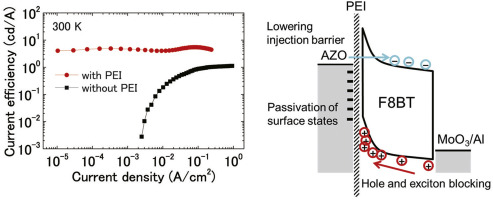Organic Electronics ( IF 2.7 ) Pub Date : 2017-08-03 , DOI: 10.1016/j.orgel.2017.07.049 Makoto Takada , Takashi Nagase , Takashi Kobayashi , Hiroyoshi Naito

|
Electron-injection mechanisms from the air-stable metal-oxide cathode to light-emitting polymer layer are studied. The device configuration is aluminum (Al) doped zinc oxide (AZO)/poly(ethyleneimine) (PEI)/poly(9,9-dioctylfluorene-alt-benzothiadiazole) (F8BT)/molybdenum trioxide/Al, known as an inverted organic light-emitting diode (iOLED). PEI reduces the electron injection barrier between AZO and F8BT by 0.4 eV, and blocks holes at AZO(PEI)/F8BT interface in iOLEDs. The accumulation of holes at the interface greatly enhances the electron injection because of the Fowler-Nordheim type tunneling injection, leading to high current efficiency of iOLEDs.
中文翻译:

带有聚乙烯亚胺电子注入层的倒置有机发光二极管中的电子注入
研究了从空气稳定的金属氧化物阴极到发光聚合物层的电子注入机理。器件配置为掺杂铝(Al)的氧化锌(AZO)/聚(乙烯亚胺)(PEI)/聚(9,9-二辛基芴-alt-苯并噻二唑)(F8BT)/三氧化钼/ Al,被称为反向有机光发光二极管(iOLED)。PEI将AZO和F8BT之间的电子注入势垒降低了0.4 eV,并阻塞了iOLED中AZO(PEI)/ F8BT界面处的空穴。由于Fowler-Nordheim型隧穿注入,界面处空穴的积累大大增强了电子注入,从而导致iOLED的高电流效率。











































 京公网安备 11010802027423号
京公网安备 11010802027423号